Vaynor is a village and community in Merthyr Tydfil County Borough. The village is about four miles north of the town of Merthyr Tydfil and is within the borders of the Brecon Beacons National Park, within the border of the historic county of Breconshire. The community includes the three villages of Cefn-Coed-y-Cymmer (Cefn Coed), Trefechan, and Pontsticill as well as Pontsarn and Vaynor itself and is notable for its connections with the Ironmaster Robert Crawshay, owner of the world’s first ironworks at Cyfarthfa, who is buried in Vaynor churchyard. The men of the Parish of Vaynor who fell during both World Wars are commemorated on a fine war memorial in the form of a Gothic Cross, which is situated on the High Street at Cefn Coed. As can be seen by its location, the memorial also commemorates the fallen of Cefn Coed.
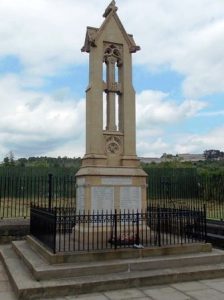
The Great War, 1914-1918
George Barnes Barker, Private, 23777, Bedfordshire Regiment. George was born in Renhold, Bedfordshire in 1883, the son of Joseph Jabez Barker and Alma Barker (nee Bendall). His father died in 1888, leaving Alma to raise their five children alone, so she was taken into Bedford Workhouse with her four younger children. George was living at Church Street, Long Buckley by 1901 where he had become an apprentice tailor. By 1911 he had moved to 81a High Street, Vaynor, where he worked as a general labourer, then prior to the war gained work at the Cardiff Corporation Reservoir at Llwynon, Cwmtaff. George married Elizabeth Jenkins at Cefn Coed in 1914 and the couple settled at 33, Pontycapel Road, Cefn Coed. George enlisted at Bedford into the Bedfordshire Regiment during the spring of 1915. He was drafted to France a year later, joining the 1st Battalion, Bedfordshire Regiment, which was attached to 15 Brigade, 5th Division. By January 1916 the battalion was billeted at Sailly-Lorette, resting and refitting, then by the end of February had moved to Doullens. At the beginning of March, the division took over positions on the Scarpe, northeast of Arras where it remained until mid-July when the division transferred south to join the great Somme offensive. The division then took part in the bloody fighting for High Wood, before seeing action during the later Battles of Guillemont, Flers-Courcelette, Morval and Le Transloy. On 5 October, after suffering heavy casualties, the Division moved to Festubert, where it remained until March 1917 when it was relieved, moving back to the Arras Sector. The division next saw action at the Battle of Arras, which opened on 9 April 1917, moving into positions at Zoave Valley after the Canadians had taken Vimy Ridge. On 21 April the 1st Bedford’s received orders to attack the village of La Coulette and on the following day moved into position. At dawn on 23 April 1917 the battalion launched its assault, suffering severe casualties. George was killed in action during the fighting that day. The 33-year-old has no known grave and is commemorated on the Arras Memorial, France.
Charles Betterton, Private, 245060, The Loyal North Lancashire Regiment. Charles was born in 1881, the son of James Betterton and Maria Betterton (nee Purnell), of 3, New Church Street, Cefn Coed. He worked as a plasterer prior to enlisting into the army at Brecon on 24 October 1916 and was posted to the 2/5th Battalion, The Loyal North Lancashire Regiment, which was at Blackdown, attached to 170 Brigade, 57th (West Lancs) Division. Charles married Elizabeth Jones, of 30, Tudor Street, Merthyr Tydfil at Siloa Independent Church, Aberdare whilst on leave in January 1917. Charles then re-joined his unit prior to it embarking for France and landed at Le Havre on 9 February 1917. The division then moved to the Outtersteene area before moving into the line in the Nursery Sector at Fleurbaix, for trench initiation. Over the coming weeks the division held the line here, before moving to the Cordonnerie Sector, where Charles was slightly wounded, then to the Ploegsteert Wood Sector, where it was bombarded by German gas shells while the Battle of Messines opened on 7 June 1917. The division then moved back into the Cordonnerie Sector until the end of July when it moved to the L’Epinette Sector, leaving there at the end of August for a brief rest before transferring into the Ypres Salient, taking over positions northeast of Poelcapelle by 24 October, to join the great fight for Passchendaele Ridge. Two days later, on 26 October 1917, Charles’ battalion launched an assault upon the ridge, but suffered terrible casualties due to an inadequate artillery barrage. Charles was killed in action during the attack that day. The 35-year-old has no known grave and is commemorated on the Tyne Cot Memorial, Belgium. His widow, Elizabeth, moved to Ffostrasol after the war and lived until 1966, having never remarried.
William Blaney, Private, 26233, South Wales Borderers. William was born in 1896, the son of Walter Blaney and Anne Blaney (nee Evans), of 20, Lower Vannor Road, Cefn-Coed. He worked for the Cardiff Corporation Waterworks, at Cwmtaff prior to the war. William enlisted at Brecon into the 3rd Battalion, South Wales Borderers in the spring of 1915 and posted to Litherland Camp at Liverpool for training. William was drafted to France early in 1916, joining the 1st Battalion, South Wales Borderers, which was in the Loos Sector, attached to 3 Brigade, 1st Division. He was wounded here in May 1916 but soon recovered and had re-joined the battalion within weeks. During July 1916 the Division moved south, to join the great Somme offensive, and the 1st SWB reached Albert by 10 July, taking up billets in the town. On the morning of 15 July, the 1st SWB received orders to proceed via the recently captured Mametz Wood to the new front line, taking over support positions behind the 2nd Welsh near Bazentin-le-Petit Wood and remained in reserve whilst 3 Brigade launched an assault against Bazentin Ridge. On 18 July the 1st SWB withdrew to the old German front line near Lozenge Wood before moving back to Albert via Becourt Wood where the men enjoyed a cold bath in the river Ancre. The 1st SWB then endured another short spell in the line before moving back to Millencourt on 26 July to rest and did not proceed into the battle zone again until 15 August, when the battalion marched via Becourt Wood and on 20 August moved back into the front line at Bazentin-le-Petit Wood, when 3 Brigade relieved 1 and 2 Brigades. The brigade endured a terrible time here over the coming days, being almost incessantly shelled by German artillery. William was wounded during this spell in the line and was evacuated to Millencourt, where he died of his wounds on 26 August 1916. The 20-year-old is buried in Millencourt Communal Cemetery Extension, France.
David Stanley Davies, Private, 17738, Royal Welsh Fusiliers. David was born at Abercrave in 1897, the son of Police Constable David Davies and Sarah Davies (nee Richards). The family moved to the Police Station at Cefn Coed in 1907, when David was promoted to Sergeant and transferred there. David worked as a wheelwright prior to enlisting at Cefn Coed into the Royal Welsh Fusiliers in November 1914. He was drafted to France on 17 May 1915, joining the 1st Battalion, Royal Welsh Fusiliers, which was in Flanders attached to 22 Brigade, 7th Division. The battalion was in the process of rebuilding following heavy losses at the Battles of Neuve Chapelle, Festubert and at Aubers Ridge, which had just closed when David arrived. The 1st RWF spent the coming weeks billeted behind the lines, before moving back into support positions by 7 June. The divisions next major action was in the Battle of Loos, which opened on 25 September 1915. The Division moved to Vermelles that morning and took part in the initial assault north of the Vermelles-Hulluch road, facing the Quarries and a series of strong-points. Suffering badly from British gas, which had blown back across the British lines, the division was badly cut up by German machine gun fire and artillery, but nonetheless seized the Quarries and only failed to penetrate the third German line due to the relative weakness of the numbers of men that got through. The 1st RWF alone suffered over 400 casualties during the day but was not relieved until three days later. On 1 October the battalion took over the line at Cambrin and enjoyed a relatively peaceful three days there before being relieved and moved into billets at Le Preol. On 7 October 1915 the battalion moved back into the line east of the La Bassée canal at Cuinchy to begin another tour. David was killed in action here that day. The 19-year-old has no known grave and is commemorated on the Loos Memorial, France.
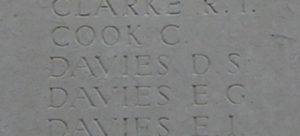
Henry George Davies, Private, 14906, South Wales Borderers. Henry was born in 1893, the son of George Henry Davies and Ann Davies, of 1, Godre Coed, Vaynor. He worked as a coal hewer prior to the war. His father had died when he was young and in 1911 his mother married Abraham Wilkes, who was only ten years older than Henry. Henry enlisted into the South Wales Borderers at Brecon on 3 September 1914 and was posted to the 7th Battalion, South Wales Borderers. The battalion formed at Brecon in September 1914, before moving to Seaford to join 67 Brigade, 22nd Division. In December the battalion moved to St. Leonard’s in billets, then completed its training at Seaford and Aldershot before embarking for France and landed at Boulogne on 6 September 1915. The Division’s stay in France was to be very short, however, as on 27 October 1915 the Division, having been moved by train to Marseilles, began to embark for Salonika as part of an Anglo-French force sent to hold the Greek border, due to the invasion of neighbouring Serbia by a combined Austro-Hungarian force. The Division remained in the Salonika theatre for the rest of the war, taking part in the Retreat from Serbia during December 1915. Large battles were fought in August 1916, at the battle of Horseshoe Hill, then in September 1916 at the battle of Machukovo. Between 24 April and 9 May 1917, the Division fought at the battle of Doiran, and then on 18 September 1918 at the Second Battle of Doiran. Henry had suffered from several bouts of ill-health during his time in Salonika, so was sent to Brecon Military Hospital upon his return in the summer of 1918, suffering from malaria and heart disease. Henry was discharged from the army Class Z on 8 January 1919 and returned home to Cefn Coed, where he died of heart disease on 15 March 1919. The 25-year-old was buried in Tabor Congregational Chapelyard in Cefn Coed. His grave is presumably unmarked, so he is commemorated on a Special Memorial within Cardiff Western Cemetery. Henry is not commemorated on the Cefn Coed and Vaynor War Memorial.
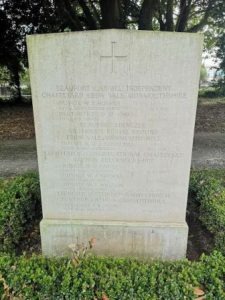
Ivor Davies, Private, DM2/117601, Royal Army Service Corps. Ivor was born at Carmarthen in 1893, the son of James Davies and Margaret Davies. The family had moved to 69, High Street, Cefn Coed by 1901 after his father had gained the position of gamekeeper on the Cyfarthfa Estate. Ivor worked as a haulier prior to the war. He enlisted into the South Wales Borderers at Bargoed on 13 October 1914 and was posted to the Depot at Brecon to join the 5th Battalion, South Wales Borderers. Just a week later, Ivor was discharged as medically unfit and in January 1916 was awarded an armlet, to show that he was a member of the Derby Scheme, which had been produced for volunteers to wear with civilian clothes to show that they were ready to fight if called upon. Ivor then re-enlisted into the Royal Army Service Corps and trained as a driver before being drafted to France in the summer of 1916, joining the 14th GHQ Motor Transport Company. Ivor survived two years on active service in France but took ill just before the Armistice and died of influenza on 12 November 1918. The 25-year-old is buried in Premont British Cemetery, Gouy, France.
John Davies, Private, 13177, South Wales Borderers. John was born at Dowlais in 1886, the son of David Davies and Elizabeth Davies. His parents were from Cardiganshire but had moved to the valleys to find work. By 1901 the family had settled at 1, Price Street, Cefn Coed. John worked as a labourer prior to enlisting at Cefn Coed into the 4th Battalion, South Wales Borderers soon after the outbreak of war. The battalion formed at Brecon, before moving to Park House Camp, near Tidworth to join 40 Brigade, 13th (Western) Division, then moved to billets in Cirencester before moving to Woking in March 1915 for final training. On 29 June 1915 the Division sailed from Avonmouth for Mudros, before landing at Cape Helles, Gallipoli on 15 July 1915. Two weeks later the Division was moved to Anzac, to reinforce the Australian and New Zealand troops there, in readiness for a great assault on the Sari Bair Ridge, in conjunction with fresh Allied landings at Suvla Bay. The assault began on 6 August 1915 and raged over the coming days. The 4th SWB reached the Achyl Dere before assaulting, and seizing Damakjelik Bair, one of the ridges held by the Turks. The Turks counter-attacked on 9 August and terrible fighting raged throughout the day. The Division remained at Gallipoli over the coming months, as the fighting drew to a close, and suffered terribly when winter hit the peninsula, bringing floods and disease. The Division was finally evacuated to Mudros on 8 January 1916 before moving to Egypt, then on 15 February 1916 embarked at Suez, arriving at Basra on 4 March to join the forces being assembled to attempt to relieve the besieged garrison of Kut-al-Amara. John was taken ill just three months after arriving in Mesopotamia and died of cholera on 29 June 1916. The 30-year-old was buried in Amara War Cemetery, Iraq.
John Thomas Davies, Private, 12005, South Wales Borderers. John was born in 1886, the son of Thomas Davies and Hannah Davies, of 9, Cefnisha, Cefn Coed. He married Hannah Maria O’Brien in 1905 and the couple settled at 5, Wern Road, Cefn Coed, where they had seven children over the coming years. John enlisted at Cefn Coed into the South Wales Borderers soon after the outbreak of war. John was drafted to France in the spring of 1916 and was posted to the 1st Battalion, South Wales Borderers, which was at Loos attached to 3 Brigade, 1st Division. During July 1916 the Division moved south, to join the great Somme offensive, and the 1st SWB reached Albert by 10 July, taking up billets in the town. On the morning of 15 July, the 1st SWB received orders to proceed via the recently captured Mametz Wood to the new front line, taking over support positions behind the 2nd Welsh near Bazentin-le-Petit Wood and remained in reserve whilst 3 Brigade launched an assault against Bazentin Ridge. On 18 July the 1st SWB withdrew to the old German front line near Lozenge Wood before moving back to Albert via Becourt Wood where the men enjoyed a cold bath in the river Ancre. The 1st SWB then endured another short spell in the line before moving back to Millencourt on 26 July to rest and did not proceed into the battle zone again until 15 August, when the battalion marched via Becourt Wood and on 20 August moved back into the front line at Bazentin-le-Petit Wood, when 3 Brigade relieved 1 and 2 Brigades. The division saw further heavy fighting on the flank of the Australian Corps during the Battle of Pozieres, then saw further fighting during the Battles of Flers-Courcelette and Morval, before wintering on the Somme and on 31 December 1916 the 1st SWB moved to reserve positions at Becourt, where it remained until 23 January 1917 when the division began to move out of the Somme sector. John was taking part in bomb throwing practise on that morning, when he was accidentally killed by the premature explosion of a bomb. The 30-year-old is buried in Contay British Cemetery, Contay, France.
Oswald Charles Davies, Sergeant, 200589, South Wales Borderers. Oswald was born at Bridgend in 1896, the son of Watkin James Davies and Marian Davies (nee Charles). The family had moved to Inglenook, Cefn Coed by 1911. Oswald enlisted into the Brecknockshire Battalion, South Wales Borderers soon after the outbreak of war. The battalion was attached to the Welsh Division and moved to Pembroke Dock upon mobilisation. It was then withdrawn from the Division and on 29 October 1914 sailed from Southampton for Bombay, where the battalion transhipped and sailed for Aden, arriving on 16 December 1914. The battalion endured a torrid time in the heat of Aden, losing several men to heatstroke. In August 1915 the battalion moved to India on garrison duties and remained there for the remainder of the war. Oswald was returning home from India for demobilisation aboard the SS Malwa when he took ill and died at sea on 14 August 1919. The 23-year-old was buried at sea. He therefore has no known grave and is commemorated on the Brookwood (United Kingdom 1914-1918) Memorial, Surrey.

William Evan Davies, Private, 267445, Monmouthshire Regiment. William was the son of Thomas and Margaret Davies, of 1, Brynhyfryd Terrace, Cefn Coed, Merthyr Tydfil. He moved to Ynismeudwy to work at the Tarreni Colliery, Godrergraig. He enlisted at Brecon during January 1915 into the Monmouthshire Regiment, and was posted to France in 1916, joining the 2nd Battalion, Monmouthshire Regiment, which was by then the pioneer battalion to the 29th Division. The Division took part in its first major action in France during the 1916 Somme Offensive and fought at the Battles of Albert and Le Transloy, suffering heavy casualties. In the Spring of 1917, it fought at the Battle of the Scarpe, which was part of the Arras Offensive. On 4 May 1917 the 2nd Monmouth’s were working on road repairs near Arras, when they came under fire from German artillery. William was struck by shrapnel which mortally wounded him, and he died within minutes. The 21-year-old is buried in Faubourg D’Amiens Cemetery, Arras, France. His mother, who had by then been widowed and become dependent on William, learned of his death through the following letter, written by an officer of the battalion: ‘Dear Mrs Davies. I am very sorry to have to inform you that your son, No. 267445 Pte. W. E. Evans, was killed on the 4th inst. He was hit by a large shell and died a few minutes afterwards. I am sure he suffered no pain, as he was unconscious to the end. Both officers and men of his company tender you their sympathies in your great loss. Your son was an excellent asset to the company; he always did his duty cheerfully under the most trying conditions and was an example to others. I need hardly say that we are all sorry to lose such a good soldier. I trust you will find consolation in the fact that he died fighting for the greatest of all causes.’ (The CWGC shows his date of death as 6 May, but the war diary confirms the officer’s letter). William is not commemorated on the Cefn Coed and Vaynor War Memorial.
Anthony Jesse Edwards, Private, 13955, South Wales Borderers. Anthony was born in 1893, the son of Edward Edwards and Elizabeth Ann Edwards (nee Jones), of 2, Maesteg Cottages, Cefn Coed. He worked as an engine driver prior to enlisting into the South Wales Borderers at Cefn Coed on 31 August 1914 and was posted to the Depot at Brecon, where he joined the 5th Battalion, South Wales Borderers. The battalion formed at Brecon in September 1914, before moving to Park House Camp, near Tidworth to join 58 Brigade, 19th (Western) Division. In December 1914 the battalion moved to Basingstoke in billets, then on 10 January 1915 became converted to the Pioneer Battalion for the 19th Division. The Division completed its training at Bulford and Perham Down, before embarking for France and landing at Le Havre on 16 July 1915. The entire 19th Division then moved to the Nursery Sector at Calonne for trench initiation alongside the Dehra Dun Brigade. The infantry battalions of the division then began carrying out the usual routines of rotating in the trenches: four days in the front line; four in support; and four in reserve, interspersed with training regimes and carrying out working parties and trench raids. Just south, the British launched a great offensive around the town of Loos on 25 September 1915, and the 19th Division was ordered to attack from its positions at the same time, to attempt to draw enemy attention away from the main battle area. The assault was a disaster, and heavy casualties were suffered by the 19th Division for no gain. The following year the Division moved to the Somme, where it took part in the second wave of the attack on Ovillers-La Boiselle on 1 July, capturing the village at heavy cost. Anthony was wounded on the Somme, being shot in the arm and sent home to Britain to recuperate. Upon returning to duty, he was drafted to Salonika on 14 January 1917 to join the 7th Battalion, South Wales Borderers, which was attached to 67 Brigade, 22nd Division. He spent the rest of the war in Salonika but contracted malaria and was invalided home again on 8 November 1918. His health continued to wane, and he was discharged from the army as medically unfit on 14 March 1919. Anthony eventually died of malaria on 17 February 1922, aged 29. Anthony is not commemorated by the CWGC, nor is he commemorated on the Cefn Coed and Vaynor War Memorial.
William Alcwyn Evans, Gunner, 730711, Royal Field Artillery. William was born in 1893, the son of John Thomas Evans and Ann Evans, of 203, High Street, Cefn Coed. He worked as a clerk for Pontycapel Brewery at Cefn Coed and then for Messrs Smyth and Daniel, Solicitors, at Merthyr prior to the war and was an organist at Moriah Welsh Calvinistic Methodist Church. William enlisted at Cardiff into the Royal Field Artillery and upon embarking for France was posted to B Battery, 107th Brigade, Royal Field Artillery. The battery was attached to the 24th Division and had seen its first action during the Battle of Loos in September 1915. It was then withdrawn from the line and didn’t see action until the summer of 1916 when it was moved to the Somme. It then fought at Delville Wood and Guillemont, before moving north of Arras in early 1917 and fought at the Battle of Vimy, alongside the Canadian Corps. In June the division moved to positions south of Ypres, and took part in the Battle of Messines, which was launched on 7 June. After the successful capture of Messines Ridge, the Division moved into the Ypres Salient, setting up its HQ at Lankhof Farm, and began the softening up process for the forthcoming Passchendaele offensive. William was killed near Dickebusch on 12 September 1917, probably by German counter-battery fire. The 24-year-old is buried in The Huts Cemetery, Belgium.
William James Frampton, Private, 25744, Welsh Regiment. William was born in 1899, the son of William Frampton and Martha Ann Frampton (nee Edwards), of Cefn Coed. He was educated at Tredegar National School. William enlisted into the 17th Battalion, Welsh Regiment at Merthyr Tydfil in the spring of 1915. The battalion was raised in January 1915 as a Bantam Battalion, made up of men of below average height, and initially went to Porthcawl attached to the 43rd (Welsh) Division. During July 1915 the battalion moved to Prees Heath to join 119 Brigade, 40th (Bantam) Division and landed in France with the Division in June 1916. The Division moved to positions around Lillers before taking over the North Maroc Sector, near Loos, for trench initiation and once acclimatised was left to hold the sector itself over the coming months. The infantry battalions of the Division then began the usual routines of rotating for duty in the trenches: normally four days in the front line; four in support and four in reserve. Late in 1916 the Division moved south to the Somme, and fought at the Battle of the Ancre, before remaining in the sector over the winter. In March 1917 the Germans withdrew to their shortened line, called the Hindenburg Line, and the 40th Division was among the units which followed the withdrawal. Later in the year the Division took part in the Battle of Cambrai and launched an attack on Bourlon Wood on 23 November 1917. The attack was carried out by 119 Brigade, led by the 12th SWB and 19th RWF. The 17th Welsh was in support for the initial assault, but was soon ordered to advance, to support the two attacking battalions. Heavy fighting raged within the wood over the coming days, with the 18th Welsh also being thrown forwards into the fight, and the Division suffered terribly. William was invalided home at some time and upon recovering was drafted out to Palestine to join the 1/5th Battalion, Welsh Regiment, which was attached to 158 Brigade, 53rd (Welsh) Division. On 30 July 1918 the battalion merged with the 1/4th Welsh to form the 4/5th Welsh. William was killed in action soon afterwards, on 19 September 1918. The 19-year-old is buried in Jerusalem War Cemetery, Israel.
William Galliers, Private, 720, South Wales Borderers. William was born at Presteign in 1865, the son of William and Catherine Galliers. He enlisted into the army as a young man and after serving for several years, seeing service in Egypt, Malta and India, moved to Cefn Coed. On 4 August 1890 William married Eleanor Jane Rees and the couple settled at 13, South Terrace, Cefn Coed, where their five children were born over the coming years. William continued to serve with the Militia then with the Brecknockshire Battalion, South Wales Borderers up until the outbreak of war. The battalion was attached to the Welsh Division and moved to Pembroke Dock upon mobilisation. It was then withdrawn from the Division and on 29 October 1914 sailed from Southampton for Bombay, where the battalion transhipped and sailed for Aden, arriving on 16 December 1914. The battalion endured a torrid time in the heat of Aden, losing several men to heatstroke. In August 1915 the battalion moved to India on garrison duties. William had by then become ill and remained at Aden for several weeks before returning back to Britain where he was hospitalised at Netley before being discharged as medically unfit. He died of general debility, including a dilated heart, emphysema and chronic bronchitis, on 8 December 1915. The 51-year-old was buried in Cefn Coed Cemetery. William is not commemorated by the CWGC nor is he commemorated on the Cefn Coed and Vaynor War Memorial.
Joseph Hicken, Sergeant, 200591, South Wales Borderers. Joseph was born at Bridgend in 1896, the son of Reverend William Henry Hicken and Alice Louisa Hicken (nee Haysome). The family moved to 149, New Road, Skewen by 1911 where Joseph found work as a plumber’s labourer. Soon afterwards, the family moved to Brynawel, Llwyn-Onn, Cefn Coed, where his father became the Missioner at the Llwyn-On Waterworks at Cwmtaff. Joseph then became a clerk at the waterworks. Joseph enlisted at Cefn Coed into the Brecknockshire Battalion, South Wales Borderers soon after the outbreak of war. The battalion was attached to the Welsh Division and moved to Pembroke Dock upon mobilisation. It was then withdrawn from the Division and on 29 October 1914 sailed from Southampton for Bombay, where the battalion transhipped and sailed for Aden, arriving on 16 December 1914. The battalion endured a torrid time in the heat of Aden, losing several men to heatstroke. In August 1915 the battalion moved to India on garrison duties. Joseph became ill during the summer of 1917 and died of disease at Bombay on 12 July 1917. The 21-year-old was buried in Sewri Cemetery, Bombay, but is commemorated on the Kirkee 1914-1918 Memorial, India, as all of the graves in Sewri were exhumed and buried in a mass grave in Kirkee in 1962.
John Arthur Howfield, MC, Lieutenant, Royal Field Artillery. John was born on 4 October 1897, the son of Arthur James Howfield, JP, and Jane Margaret Howfield (nee Price), of Vaynor House, Merthyr Tydfil. He was educated at Merthyr County School and then at Worcester Royal Grammar School from 1911 to 1916 and upon leaving school was commissioned as Second Lieutenant into the Royal Field Artillery in June 1916. John embarked for France on 3 April 1917, joining the 75th Brigade, Royal Field Artillery, which was attached to the Guards Division. The division had followed the German withdrawal to the Hindenburg Line just prior to John’s arrival in France and later that year moved north to Ypres, taking part in the opening assault at the Battle of the Pilckem Ridge. The division saw further fighting there during the Battle of the Menin Road, then took part in the Battle of Poelcapelle and the First Battle of Passchendaele. November saw the division move south, where it took part in the Battle of Cambrai, seeing heavy fighting during the German counterattack. The division wintered in the Cambrai Sector and on 21 March 1918 faced the German spring offensive, suffering heavy casualties as the line was driven back over the coming days. John gained the award of the Military Cross during this period. The award was published in the London Gazette of 23 April 1918 and read: ‘For conspicuous gallantry and devotion to duty. Under heavy shell fire he attended to the casualties that occurred at the ammunition dump of which he was in charge and succeeded in getting the men under cover of a building. When the building was set on fire by a shell, at great personal risk he dashed into and rescued a man whose clothes had been set on fire. He has always set a fine example of cheerfulness and courage under all conditions. The line then stabilised as the fighting moved north to the Lys and the Guards Division rebuilt over the summer. On 8 August the Australian Corps advanced towards the town of Villers Bretonneux and won a mighty battle there against the Germans, thus turning the war. On 21 August the British launched an attack on the Somme, and the Guards Division launched its assault from the direction of Hamelincourt, crossing the Achiet to Arras railway towards St. Leger. On 1 September 1918 the division attacked from Mory towards Longatte Trench and the Noreuil Switch Line. John had gone forward to carry out observational work and was in a dugout when it was hit by a German shell that day, killing him instantly. The 20-year-old is buried in Bucquoy Road Cemetery, Ficheux, France.
Philip Robert Hughes, Private, 8669, Royal Welsh Fusiliers. Philip was born in 1888, the son of Amelia Hughes, of 45, Field Street Court, Cefn Coed. His mother married Thomas Davies in 1899 and Philip was raised as his son, at 1, White Horse Court, Cefn Coed. Philip worked as a collier prior to enlisting into the Welsh Regiment Militia at Merthyr on 17 January 1905, then transferred to the regular army, joining the Royal Welsh Fusiliers at Cardiff on 13 February 1905. Philip was then posted to the Depot at Wrexham, before being posted to the 1st Battalion, Royal Welsh Fusiliers three months later. Philip served in India and Burma with the regiment over the coming years and upon his return to Britain in 1912 left the army, joining the Army Reserve and found work as a collier at Cefn Coed. Philip was mobilised following the outbreak of war, and embarked for France with the 2nd Battalion, Royal Welsh Fusiliers on 13 August 1914. The battalion was initially placed on Lines of Communication at Rouen, before joining 19 Brigade at Valenciennes, taking part in the retreat to the Marne with the BEF. Following the Battles of the Marne and the Aisne, 19 Brigade moved to Flanders with the BEF, and eventually took over the La Boutillerie sector after becoming attached to the 6th Division. The 2nd RWF was in the line at Bois Grenier when Philip was wounded during a German bombardment on 20 April. He was evacuated to the 19th Field Ambulance where he died of his wounds on the following day, 30 April 1915. The 26-year-old is buried in Erquinghem-Lys Churchyard Extension, France.
William James, Gunner, 188510, Royal Field Artillery. William was born in 1896, the son of William James and Mary James, of 48, High Street, Cefn Coed. He worked as a Clerk at the Merthyr Gasworks prior to the war. William enlisted at Cefn Coed into the Royal Field Artillery and was posted to B Battery, 211th Brigade, Royal Field Artillery, which was attached to the 42nd (East Lancashire) Division. The division had taken part in the Gallipoli campaign in 1915 before being evacuated to Egypt, where it spent over a year before being transferred to the Western Front in February 1917, taking over the line near Épehy then Havrincourt. In September the division moved north to Ypres, where it fought during the early phases of the Passchendaele offensive, before moving to the Coast to refit. November 1917 saw the division move to positions at Givenchy, where it remained until moving back south in early 1918. Here the division faced the German Spring Offensive of 21 March 1918 and saw heavy fighting as the Allied line was driven back over the coming days. The offensive stalled for several months after the Germans turned their attention to the Lys and then the Champagne sectors. A great Australian victory at Villers Bretonneux on 8 August saw the tide of war turn. The British attacked the German lines on the Somme on 21 August, with the 42nd Division in the line, and began the great offensive that was eventually to end the war. William was killed in action two days prior to this, on 19 August 1918, whilst the 211th Brigade was moving its guns into position west of Serre. The 21-year-old is buried in Bertrancourt Military Cemetery, France.
Richard James Jenkins, Lance Corporal, 33994, Royal Welsh Fusiliers. Richard was born in 1892, the son of James Jenkins and Margaret Jenkins, of 25, Quarry Row, Cefn Coed. He worked as a collier prior to the war. Richard enlisted at Brecon into the 3rd Battalion, South Wales Borderers on 12 August 1914. He was drafted to France on 4 January 1915, joining the 1st Battalion, South Wales Borderers, which was in positions north-east of Bethune, near Richebourg attached to 3 Brigade, 1st Division. The 1st Division took part in its first major action of 1915 here on 9 May 1915, during the Battle of Aubers Ridge, when it attacked alongside the Meerut Division. The attack of the 2nd Welsh was held up by a flooded ditch, which the men forded, before being hit by heavy machine-gun fire, and a large number of casualties were suffered before the survivors withdrew. After the battle of Aubers, 3 Brigade took over a section of old French trenches, where it received drafts of reinforcements. On 20 May, the Division was moved to the Cuinchy area, where it endured a great deal of bombing and rifle grenading. On 20 May 1915 Richard was attached to the 170th Tunnelling Company, spending a month with them before re-joining the 1st SWB. By then the division had moved to the Vermelles area, in preparation for the battle of Loos. The Battle of Loos was launched on 25 September 1915, following the release of large quantities of poison gas by the British. 3 Brigade moved off with the 2nd Munster’s on the right, the 2nd Welsh in echelon, to their left, and the 1st SWB in support. The gas had blown back over the British lines, so conditions during the advance were horrendous, then whilst advancing past the Vermelles-Hulluch Road the Brigade came under heavy machine-gun fire. The division suffered terrible casualties during the opening days of the battle but remained in the area over the coming weeks. Richard was wounded in the thigh at Loos on 10 October 1915 and was evacuated back to Britain for further treatment. Upon recovering, Richard embarked for Gibraltar to join the 1st (Garrison) Battalion, Royal Welsh Fusiliers, but was diverted to France again on 30 December 1916 and was posted to the 10th Battalion, Royal Welsh Fusiliers, which was attached to 76 Brigade, 3rd Division. Richard was wounded in the neck on 10 April and admitted to the 22nd General Hospital, where he spent a month recuperating before re-joining the battalion. On 2 August he returned home on ten days leave, and just a month after returning to France was wounded by gas during a training course at Rocquigny when his respirator failed, and he was hospitalised again. Richard re-joined the battalion on 2 October, by which time the 3rd Division had moved into the Ypres Salient. The division then saw heavy fighting here during the Battle of the Menin Road and the Battle of Polygon Wood. In November the Division moved south again, where it fought at the Battle of Cambrai, and it was still in the area when the Germans launched their spring offensive on 21 March 1918, seeing heavy fighting as the lines were driven back over the coming days. The division then moved to Flanders to rebuild; however, it became caught up in desperate fighting again when the Germans launched the second phase of their offensive on the Lys on 9 April 1918. Richard was killed in action here on 21 April 1918. The 25-year-old is buried in Chocques Military Cemetery, France.
David John Jones, Private, 15586, South Wales Borderers. David was born in 1887, the son of John Jones and Sarah Jones, of 6, Penry Street, Merthyr Tydfil. He married Margaret Mary Davies in 1907 and the couple settled at 52, Field Street, Cefn Coed, where their two daughters were born over the coming years. David worked as an underground coal haulier prior to enlisting at Cefn Coed into the South Wales Borderers soon after the outbreak of war. David was drafted to France in the Spring of 1916, joining the 1st Battalion, South Wales Borderers, which was at Loos attached to 3 Brigade, 1st Division. The division had been in the Loos Sector since taking part in the Battle of Loos the previous year, where it had suffered terrible casualties. On 13 January 1916 the 1st SWB left its billets at Noeux-les-Mines and moved into the rear area at Ferfay to rest and refit. David probably joined the battalion during this period. On 14 February the battalion moved back to Maroc, in the Loos Sector, and moved into support trenches. The battalion then began the usual routines of trench rotation, usually consisting of four days in support, four days in the front line and four in reserve, interspersed with fatigues and carrying out working parties. On 25 April 1916 the 1st SWB was enjoying a rare spell out of the lines in billets at Les Brebis, when the Germans began shelling the town. David was killed when a shell struck a billet housing C Company, causing heavy casualties. The 29-year-old was buried in Bully-Grenay Communal Cemetery, French Extension, France.
David John Jones, Private, 93609, Royal Welsh Fusiliers. David was born at Cefn Coed in 1898, the illegitimate son of Norah Margaret Jones. He was raised by relatives until Norah married Thomas Simons in 1906, and moved in with his stepfather at 16, Cefn Isaf, Cefn Coed. David worked as a collier prior to enlisting at Brecon into the South Wales Borderers on 23 April 1918 and was probably posted to Kinmel Park for training. Upon being drafted to France on 21 August 1918, he was initially posted to the 2nd Battalion, Royal Welsh Fusiliers, before being transferred to the 17th Battalion, Royal Welsh Fusiliers, which was in the same 115 Brigade, 38th (Welsh) Division. The division was in the process of advancing from its summer positions on the Somme, following the launching of the great offensive on 21 August and had rapidly recaptured the old Somme battlefields of 1916 whilst heading towards the Hindenburg Line. The division recaptured Thiepval Ridge and Pozieres Ridge on the opening day, then cleared Longueval and Delville Wood on 29 August. David was wounded during the fighting for Longueval and was evacuated behind the lines to the 3rd Casualty Clearing Station at Gézaincourt, where he died of his wounds on 2 September 1918. The 20-year-old is buried in Bagneux British Cemetery, Gézaincourt, France. His stepfather, Thomas Simons, had been killed at Ypres in October 1914.
Richard Jones, Private, 28143, Welsh Regiment. Richard was born in 1885, the son of David Jones and Margaret Jones, of 70, Field Street, Cefn Coed. He worked as a quarryman, before beginning work at the Pontycapel Brewery, Cefn Coed some years prior to the war. Richard enlisted into the 18th Battalion, Welsh Regiment in the spring of 1915. The battalion was raised in January 1915 as a Bantam Battalion, made up of men of below average height, and initially went to Porthcawl attached to the 43rd (Welsh) Division. During July 1915 the battalion moved to Prees Heath to join 119 Brigade, 40th (Bantam) Division and landed in France with the Division in June 1916. The Division moved to positions around Lillers before taking over the North Maroc Sector, near Loos, for trench initiation and once acclimatised was left to hold the sector itself over the coming months. The infantry battalions of the Division then began the usual routines of rotating for duty in the trenches: normally four days in the front line; four in support and four in reserve. Late in 1916 the Division moved south to the Somme, and fought at the Battle of the Ancre, before remaining in the sector over the winter. In March 1917 the Germans withdrew to their shortened line, called the Hindenburg Line, and the 40th Division was among the units which followed the withdrawal. Richard came home on leave early in November 1917 and on 19 November married Elizabeth Sarah Rees of 37, South Terrace, Cefn Coed. He probably missed the Divisions assault on Bourlon Wood on 23 November 1917, as he would not have been back in time. The division suffered severe casualties at Bourlon Wood but remained in the area over the coming months. On 21 March 1918 the division was hit hard following the launching of the German Spring offensive and saw heavy casualties as it was forced to retire. The battered division then moved north to Flanders to rest and rebuild, but on 9 April the Germans launched a second offensive in Flanders, and the 40th Division was caught up in the thick of it again. Richard was taken prisoner by the Germans during this terrible time and eventually ended up in a prisoner of war camp at Soltau, in Germany. His health suffered in captivity, and he died of inflammation of the lungs on 10 July 1918. The 33-year-old is buried in Hamburg Cemetery, Germany.
William George Jones, Private, 12255, South Wales Borderers. William was born in 1890, the son of Susannah Jane Jones. His mother married William George Adlam on 1 July 1893 and William was raised as his son at 3, Cross Street, Cefn Coed. William worked as a coal hewer for several years prior to enlisting at Brecon into the 4th Battalion, South Wales Borderers in August 1914. The battalion formed at Brecon, before moving to Park House Camp, near Tidworth to join 40 Brigade, 13th (Western) Division, then moved to billets in Cirencester before moving to Woking in March 1915 for final training. On 29 June 1915 the Division sailed from Avonmouth for Mudros, before landing at Cape Helles, Gallipoli on 15 July 1915. Two weeks later the Division was moved to Anzac, to reinforce the Australian and New Zealand troops there, in readiness for a great assault on the Sari Bair Ridge, in conjunction with fresh Allied landings at Suvla Bay. The assault began on 6 August 1915 and raged over the coming days. The 4th SWB reached the Achyl Dere before assaulting, and seizing Damakjelik Bair, one of the ridges held by the Turks. The Turks counter-attacked on 9 August and terrible fighting raged throughout the day. The Division remained at Gallipoli over the coming months, as the fighting drew to a close, and suffered terribly when winter hit the peninsula, bringing floods and disease. The Division was finally evacuated to Mudros on 8 January 1916 before moving to Egypt, then on 15 February 1916 embarked at Suez, arriving at Basra on 4 March to join the forces being assembled to attempt to relieve the besieged garrison of Kut-al-Amara. William was posted as missing soon after the arrival of the division in Mesopotamia and was thought to have been taken prisoner by the Turks. It was almost a year before he was declared as having been killed in action on 9 April 1916. The 25-year-old has no known grave and is commemorated on the Basra Memorial, Iraq.
Edward James Kirby, Private, 17743, Royal Welsh Fusiliers. Edward was born in 1897, the son of Edward Kirby and Sarah Margaret Kirby (nee James), of 9, Fair View Houses, Cefn Coed. He worked as a collier prior to enlisting at Cefn Coed into the Royal Welsh Fusiliers soon after the outbreak of war. Edward was drafted to France on 30 November 1915, joining the 1st Battalion, Royal Welsh Fusiliers, which was in the Cuinchy sector, attached to 22 Brigade, 7th Division. The division had seen heavy fighting at Loos during the previous weeks, especially during the actions around the Quarries. On 5 December 1915 the battalion left Flanders, entraining at Lillers for Saleux, some eight miles southwest of Amiens, then marched to Montagne to billets. The battalion remained here over the coming weeks, resting, refitting and carrying out specialist training, before the 7th Division took up positions on the Somme, facing Fricourt. The 1st RWF finally left Montagne on 30 January 1916 when it began marching towards the division’s new positions, and on 2 February took over trenches east of Méaulte. Over the coming weeks the infantry battalions of the division rotated between duty in the front line, whilst the Allies began to prepare for a great offensive on the Somme. The Division took part in the opening assault of the Somme offensive on 1 July 1916, advancing from positions near Bois Francais, near Fricourt, and captured the village of Mametz, one of the few successes of 1 July 1916. The battalion then took part in further attacks to push forwards, to the south of Mametz Wood, and upon being relieved, witnessed the troops of the 38th (Welsh) Division moving forward to launch its assault on Mametz Wood. On 14 July, with the wood taken, the 7th Division moved back into the line, with orders to capture Bazentin-le-Petit, before taking part in the terrible attacks on High Wood over the coming days. Edward was badly wounded during this period and was evacuated to hospital in Rouen, where he died of his wounds on 22 July 1916. The 19-year-old is buried in St. Sever Cemetery, Rouen, France.
David Lewis, Private, 11562, South Wales Borderers. David was born in 1885, the son of Alexander Lewis and Mary Lewis (nee Evans), of 15, Field Street, Cefn Coed. He worked as an underground colliery haulier prior to enlisting at Merthyr into the South Wales Borderers soon after the outbreak of war. David embarked for France on 13 November 1914, joining the 1st Battalion, South Wales Borderers, which was in Flanders, attached to 3 Brigade, 1st Division. The division had suffered terrible casualties during its vital actions during the defence of Ypres the previous weeks and had just moved to new positions near Outtersteene to rebuild. On 20 December the now rebuilt 1st SWB left for Merris, before the 1st Division took up new positions in the line at Festubert, a wet marshy area. David is officially recorded as having been killed in action at Festubert on 21 December 1914, however the 1st SWB did not enter the line there until the following day, making an assault later that afternoon, so David was most likely killed on that following day, 22 December 1914. The 29-year-old has no known grave and is commemorated on the Le Touret Memorial, Richebourg-L’avoue, France. Two of his brothers, Evan Lewis and John Lewis, were also killed during the war, both in 1915.
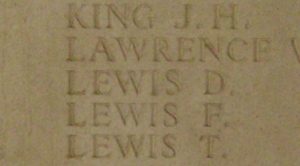
Edward Lewis, Private, 241741, Welsh Regiment. Edward was born in 1899, the son of William Lewis and Miriam Price Lewis (nee Thomas), of 72, Field Street, Cefn Coed. He worked as a collier prior to enlisting into the 5th Battalion, Welsh Regiment at Pontypridd in February 1915 and was drafted to Egypt to join the 1/5th Battalion, Welsh Regiment, which was attached to 158 Brigade, 53rd (Welsh) Division. The Division had been evacuated from Gallipoli in December 1915, moving to Egypt to join the EEF, and helped guard the Suez Canal before taking part in operations to drive the Turks out of the Sinai. The EEF then turned its attention onto driving the Turks out of Palestine, and on 26 March 1917 launched its first offensive against the coastal city of Gaza, which guarded the road to Jerusalem. Initial gains during the day were lost when the assaulting divisions lost touch with each other, and communication broke down when a thick fog cloaked the battlefield. A second attempt to force Gaza was launched on 17 April, which also failed, and the EEF suffered a change in leadership, with Sir Edmund Allenby assuming command, before being re-organised, and a third offensive was launched against a wider front from Beersheba to Gaza on 31 October 1917. This time the Turkish defences were breached, and the road to Jerusalem now lay open and the EEF began to advance north. Edward was wounded during the opening day of this Third Battle of Gaza and died of his wounds on 4 November 1917. The 18-year-old is buried in Beersheba War Cemetery, Israel.
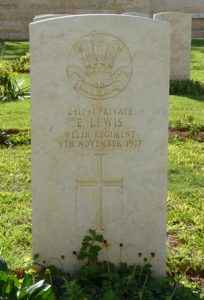
Evan Lewis, Private, 13164, Welsh Regiment. Evan was born in 1881, the son of Alexander Lewis and Mary Lewis (nee Evans), of 15, Field Street, Cefn Coed. He worked as a collier at Pontygwaith prior to enlisting at Merthyr into the Welsh Regiment soon after the outbreak of war. Evan was drafted to France on 29 November 1914, joining the 2nd Battalion, Welsh Regiment, which was attached to 3 Brigade, 1st Division. The division had suffered terrible casualties during its vital actions during the defence of Ypres the previous weeks and had just moved to new positions near Outtersteene to rebuild. The 1st Division then took up new positions in the line at Festubert, a wet marshy area. On Christmas Day the men were in the trenches, cold and wet, when they were presented with their Princess Mary gift tins, which contained cards and gifts on behalf of the Royal Family. The line was relatively quiet over this period, but the trenches were flooded and in a terrible state. The division then took over new positions at Givenchy in January 1915. At dawn on 25 January 1915 the Germans hit their lines with an intensive artillery bombardment, before launching an infantry assault, breaking through 100 yards of trench and reaching Givenchy village. Heavy fighting raged throughout the day as the Germans were driven back and the line regained. The line then settled down for a while, until the 1st Division launched its first major action of 1915 here on 9 May 1915, during the Battle of Aubers Ridge, when it attacked alongside the Meerut Division. The attack of the 2nd Welsh was held up by a flooded ditch, which the men forded, before being hit by heavy machine-gun fire, and many casualties were suffered before the survivors withdrew. Evan was killed in action during the assault that day. The 34-year-old has no known grave and is commemorated on the Le Touret Memorial, Richebourg-L’avoue, France. Two of his brothers were also killed during the war, David Lewis in 1914 and John Lewis in 1915.
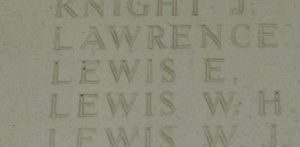
John Lewis, Private, 13333, Welsh Regiment. John was born as John Evans at Penderyn in 1872, the son of Mary Evans. His mother later married Alexander Lewis and the family settled at 15, Field Street, Cefn Coed. John worked as a labourer and lodged at 16, Chapel Road, Penderyn prior to the war. He enlisted at Bargoed into the Welsh Regiment in August 1914 and embarked for France on 29 November 1914, joining the 2nd Battalion, Welsh Regiment, which was attached to 3 Brigade, 1st Division. The division had suffered terrible casualties during its vital actions during the defence of Ypres the previous weeks and had just moved to new positions near Outtersteene to rebuild. The 1st Division then took up new positions in the line at Festubert, a wet marshy area. On Christmas Day the men were in the trenches, cold and wet, when they were presented with their Princess Mary gift tins, which contained cards and gifts on behalf of the Royal Family. The line was relatively quiet over this period, but the trenches were flooded and in a terrible state. The division then took over new positions at Givenchy in January 1915. At dawn on 25 January 1915 the Germans hit their lines with an intensive artillery bombardment, before launching an infantry assault, breaking through 100 yards of trench and reaching Givenchy village. Heavy fighting raged throughout the day as the Germans were driven back and the line regained. The line then settled down for a while, until the 1st Division launched its first major action of 1915 here on 9 May 1915, during the Battle of Aubers Ridge, when it attacked alongside the Meerut Division. The attack of the 2nd Welsh was held up by a flooded ditch, which the men forded, before being hit by heavy machine-gun fire, and many casualties were suffered before the survivors withdrew. After the battle of Aubers, the 2nd Welsh took over a section of old French trenches, where it received drafts of reinforcements. On 20 May, the Battalion was moved to the Cuinchy area, where it endured a great deal of bombing and rifle grenading. John was killed in action here on 25 May 1915. The 43-year-old has no known grave and is commemorated on the Ypres (Menin Gate) Memorial, Belgium. Two of his brothers were also killed during the war, David Lewis in 1914 and Evan Lewis in 1915.
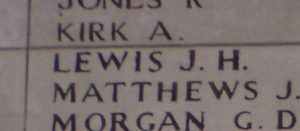
Thomas William Lewis, Private, 201100, South Wales Borderers. Thomas was born in 1888, the son of William Lewis and Gwenllian Lewis (nee Watkins), of 44, High Street, Cefn Coed. He worked as a Masons Labourer and then at the Dowlais Steelworks prior to enlisting at Brecon into the 2/1st Brecknockshire Battalion, South Wales Borderers. The battalion had formed at Brecon in September 1914. It left Brecon for Dale, in Pembrokeshire in April 1915 to join the Milford Haven garrison, then at the end of 1915 moved to Bedford to join the 68th (2nd Welsh) Division. In November 1916 the battalion was absorbed by the 2/7th Battalion, Royal Welsh Fusiliers at Wrentham, near South Wold, and moved to Benacre Camp, Wrentham. Thomas was drafted to India at some time after this, joining the 1/1st Brecknockshire Battalion, South Wales Borderers, which was on garrison duties in Mhow. Thomas took ill just before the Armistice and died of influenza in hospital at Isidore, India on 7 November 1918. The 30-year-old has no known grave and is commemorated on the Kirkee 1914-1918 Memorial, India.
William Watkin Meredith, Trooper, D/12686, 3rd Dragoon Guards. William was born in 1895, the son of John Meredith and Elizabeth Ann Meredith (nee Williams), of 4, Price Street, Cefn Coed. He worked for his father at the Watkins Brewery at Cefn Coed prior to the war. William enlisted into the Royal Berkshire Regiment on 13 November 1914, then spent time serving with the Labour Corps before embarking for France in 1916 to join the 3rd Dragoon Guards. William was badly wounded during the war, suffering multiple wounds to his legs and was discharged from the army as medically unfit on 4 June 1918, returning home to Cefn Coed. William died at home on 2 August 1923, aged 28. Nothing further is known of him as he is not commemorated by the CWGC, so nothing further is known of him.
Hugh Tregerthen Morris, MM, Sergeant, 43786, Royal Engineers. Hugh was born in 1895, the son of Thomas Morris and Mary Ellen Morris (nee Jenkins), of Taff Brae, Cefn Coed. His father was a County Councillor and the manager of the Pontycapel Brewery, at Cefn Coed, but following his death in 1902, the family moved to 21, The Parade, Barry. Hugh was educated at Barry County School before gaining an apprenticeship as a fitter at the Locomotive Department of the Barry Railway. Hugh enlisted into the Royal Engineers soon after the outbreak of war and was posted to the 19th Divisional Signal Company. The Division assembled around Bulford during September 1914, and Divisional training was completed near Tidworth, from March 1915. The Division moved to France during July 1915, and moved to positions near Loos, where it took part in the opening attack of the Battle of Loos on 25 September 1915. The following year the Division moved to the Somme, where it took part in the second wave of the attack on Ovillers-La Boiselle on 1 July, capturing the village at heavy cost. It then fought through the Somme Battles of Pozieres and the Ancre in 1916. In 1917 the Division moved North to Ypres, taking part in the Battle of Messines. After a brief rest, where the Division rebuilt its strength, it then took part in the main Passchendaele offensive, which was launched on 31 July 1917. By October the Division had moved to the Merris area, and carried out several weeks of training whilst rebuilding, before moving south in the first week of December, taking over a section of the front line in the Ribecourt Sector. The Division wintered here, holding this sector over the coming months. At dawn on 21 March 1918 the Division was hit hard by the opening assault of the German Spring offensive, Operation Michael, and suffered terrible casualties during a fighting withdrawal over the coming days. The battered Division was relieved by the Australians, before being sent to the quieter Messines sector again on 30 March, to rest and rebuild. Hugh was recommended for his gallantry during this trying period: ‘When in charge of the brigade signallers at the evacuation of Cambrai, while their position was being subjected to fierce and unexpected shelling, Sergt. Morris set a fine example of daring and self-control, carrying on the work with the communication wires, and encouraging his men with a spirit which has been publicly recognised by the award of the Military Medal for bravery in the field.’ (His Captain recommended him for the Distinguished Conduct Medal, but the award was downgraded to the Military Medal.’ Soon after the battered division moved to Flanders, the Germans launched the second phase of their offensive there on 9 April 1918, and the division was caught up in desperate fighting around Messines Ridge. Hugh was wounded on 18 April and was evacuated to hospital at Boulogne, where he died of his wounds on 29 April 1918. The 22-year-old was buried in Boulogne Eastern Cemetery, France. His brother, Noel Dyke Morris, had died of wounds in 1916. Neither man is commemorated on the Cefn Coed and Vaynor War Memorial.
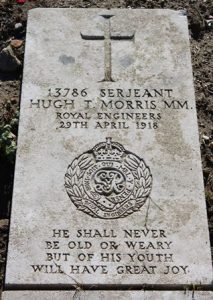
Noel Dyke Morris, Lieutenant, South Lancashire Regiment. Noel was born in 1894, the son of Thomas Morris and Mary Ellen Morris (nee Jenkins), of Taff Brae, Cefn Coed. His father was a County Councillor and the manager of the Pontycapel Brewery, at Cefn Coed, but following his death in 1902, the family moved to 21, The Parade, Barry. Noel was educated at Barry County School before gaining a place at the University of Wales at Aberystwyth and was later awarded a scholarship at Jesus College, Oxford. Noel was commissioned from the OTC on 9 September 1914, and in October 1915 was posted to France with the 8th Battalion, South Lancashire Regiment, which was attached to 75 Brigade, 25th Division. The Division landed in France on 26 September 1915, and was posted to the Vimy area, where it defended Vimy Ridge against a German attack in May 1916. Noel was wounded by a German aerial torpedo whilst in the trenches at Neuville St. Vaast on 4 May, and was evacuated to the Base Hospital at Étaples, where he died of his wounds on 12 May 1916. The 22-year-old is buried in Étaples Military Cemetery, France. His brother, Hugh Tregerthen Morris, died of wounds in 1918. Neither man is commemorated on the Cefn Coed and Vaynor War Memorial.
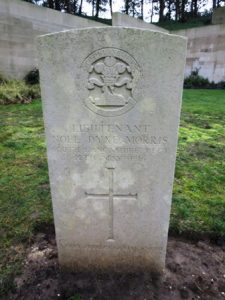
Gregory William Nicholls, Private, PLY/6414, Royal Marine Light Infantry. Gregory was born at Ilfracombe on 2 October 1873, the son of Edward Nicholls and Ellen Nicholls (nee Dart). He left home as a young man and enlisted into the Royal Marines at Bristol on 2 January 1893. Gregory was posted to the RM Depot at Walmer for training, then over the coming years served on a variety of vessels. He married Margaret Maria Groombridge at the Parish Church at Walmer on 4 April 1900. Gregory continued to serve with the Royal Marines over the coming years, before leaving the forces and joining the reserve at the beginning of 1914. The family then came to live at 8, Fair View Houses, Cefn Coed. Gregory was recalled to the colours following the outbreak of war and was posted aboard the pre-dreadnaught battleship HMS Majestic. She was attached to the Channel Fleet during the early stages of the war before being detached for escort duties with Canadian troop convoys. She then had spells as a guard ship at the Nore and the Humber, then early in 1915, she was dispatched to the Mediterranean for service in the Dardanelles Campaign. Majestic participated in bombardments of Turkish forts and supported the Allied landings at Gallipoli on 25 April 1915, then over the coming weeks continued to support the infantry ashore by utilising her massive guns. On 27 May 1915 Majestic was stationed off W Beach at Cape Helles when she was torpedoed by the German submarine U-21. The torpedo set off a huge internal explosion and Majestic sank in less than ten minutes with the loss of 49 men. Gregory was 42 years old when he was lost during the sinking that day. He has no known grave and is commemorated on the Plymouth Naval Memorial, Devon.
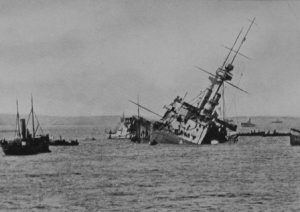
Edwin David J Powell, Private, 241740, Welsh Regiment. Edwin was born in 1898, the son of Edwin Powell and Margaret Powell (nee Jones), of 218, High Street, Cefn Coed. He enlisted at Pontypridd into the 5th Battalion, Welsh Regiment in 1916 and after completing his training was drafted to the 1/5th Battalion, Welsh Regiment, which was in Egypt attached to 158 Brigade, 53rd (Welsh) Division. Edwin began his journey in April 1917, firstly sailing for France, and then entraining for Marseilles, where he boarded the requisitioned troopship SS Transylvania. On 3 May 1917, Transylvania sailed from Marseille for Alexandria with a full complement of troops, escorted by the Japanese destroyers Matsu and Sakaki. At 10.00 on the following morning, 4 May 1917, she was steaming south of Cape Vado near Savona, in the Gulf of Genoa, when she was hit by a torpedo which had been fired by the German submarine U-63 and began to sink. Matsu came alongside Transylvania and began to take on board troops while Sakaki circled to force the submarine to remain submerged, however some twenty minutes later a second torpedo was fired by the submarine which hit Transylvania, which sank immediately. Edwin was among the 413 people who lost their lives during the sinking that day. The 19-year-old has no known grave so is commemorated on the Savona Memorial, Italy.
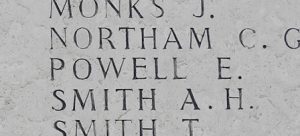
Brinley Rees Price, Private, 245061, The Loyal North Lancashire Regiment. Brinley was born in 1892, the son of Rees Price and Mary Anne Price (nee James), of Pentwyn House, High Street, Cefn Coed. He worked as a solicitor’s clerk prior to enlisting into the 2/5th Battalion, The Loyal North Lancashire Regiment at Brecon on 24 October 1916, joining the battalion at Blackdown, where it was attached to 170 Brigade, 57th (West Lancs) Division. The battalion left Blackdown and landed at Le Havre on 9 February 1917, moving to positions in the Fleurbaix Sector for trench initiation. After a month of training the division took over the Cordonnerie Sector, where it remained until taking over the Ploegsteert Wood sector at the beginning of June and endured a trying time as the Battle of Messines Ridge opened just to their north on 7 June. After a brief rest at Armentieres in September, the division moved into the Ypres Salient, taking over positions at Poelcapelle by 24 October, joining the great fight for Passchendaele Ridge. On the following morning the 2/5th Loyal’s moved into the front line and prepared to launch an assault on the following morning. At 05.40 on 26 October 1917 the battalion made its assault, but due to an inadequate artillery barrage prior to the assault, came under heavy machine-gun fire and suffered terrible casualties. Brinley was killed in action during the day. The 25-year-old has no known grave and is commemorated on the Tyne Cot Memorial, Belgium.
John Thomas Price, Private, 200590, South Wales Borderers. John was born in 1893, the son of Thomas Price and Mary Ann Price, of 169, High Street, Cefn Coed. He worked as a mason prior to enlisting into the Brecknockshire Battalion, South Wales Borderers soon after the outbreak of war. The battalion was attached to the Welsh Division and moved to Pembroke Dock upon mobilisation. It was then withdrawn from the Division and on 29 October 1914 sailed from Southampton for Bombay, where the battalion transhipped and sailed for Aden, arriving on 16 December 1914. The battalion endured a torrid time in the heat of Aden, losing several men to heatstroke. In August 1915 the battalion moved to India on garrison duties. John was then posted to Mesopotamia to join the 17th Division Signal Company, Royal Engineers. He drowned at Samarrah, on the east bank of the Tigris, on 22 June 1918. The 25-year-old has no known grave and is commemorated on the Basra Memorial, Iraq. (John is the man named on the memorial as Sapper J Price).
Thomas Walter Riddell, Gunner, 80121, Royal Garrison Artillery. Thomas was born in Llanberis in 1897, the son of William Henry Riddell and Ellen Marion Riddell (nee Bennett). His mother died in 1903 and his father married Louisa Phillips in 1906, before moving the family to Devonia, Cwm Taff Road, Cefn Coed. Thomas worked as a grocer’s assistant after leaving school. He enlisted at Cefn Coed into the Royal Garrison Artillery on 9 December 1915 and was placed on the army reserve until 15 May 1916, when he was mobilised and posted to Fort Brockhurst, in Kent for training and carried out specialist training as a signaller. Thomas was then posted to the 133rd Siege Battery, Royal Garrison Artillery, and embarked for France with the battery on 17 September 1916. The battery then moved to the Somme, taking part in the latter stages of the Somme offensive. The battery then moved to the Arras Sector, setting up its guns at Agny and supported the Allied assault during the opening stages of the Battle of Arras, which opened on 9 April 1917, before moving its guns to St. Martin Sur Cojeul. The battery was relieved from here on 15 May and began to move north, taking over positions at Kemmel on the southern edge of the Ypres Salient, and began registering its guns in preparation for the forthcoming Battle of Messines Ridge. Thomas was wounded here in the days leading up to the battle and died of his wounds on 6 June 1917. The 20-year-old is buried in Locre Hospice Cemetery, Belgium.
Thomas Simons, Private, 7717, Welsh Regiment. Thomas was born in Dowlais in 1883, the son of Mary Jane Simons. He was raised by his grandparents, Thomas and Margaret Simons, at Merthyr. Thomas had enlisted into the Welsh Regiment at Merthyr on 17 July 1900 and served for several years until leaving the army and in 1906 he married Norah Margaret Jones at Cefn Coed. The couple settled at 5, Rock Lane, Cefn Coed, where their four children were born over the coming years. As a former soldier, Thomas was an army reservist and following the outbreak of war was mobilised, joining the 2nd Battalion, Welsh Regiment. The battalion entrained for the south coast within days of war breaking out and on 13 August 1914 landed in France. The battalion was attached to 3 Brigade, 1st Division and entrained for the Belgian frontier, near the town of Mons. The Division then took part in the Battle of Mons on 23 August, following the German invasion of the low countries, and in the epic withdrawal from Mons to the River Marne, where the German drive on Paris was halted. The Germans then withdrew north and took up defensive positions north of the river Aisne, along the Chemin des Dames Ridge and the BEF advanced before launching a frontal attack upon the German positions. The BEF then began moving to Flanders on 17 October, before advancing from Poperinghe past endless numbers of refugees and took up positions guarding the strategically vital city of Ypres, the 1st Division taking up positions near Langemarck by 21 October. Later that day the division was attacked by hordes of Germans, mainly young student-soldiers, who were mown down by the highly trained British soldiers. The Germans maintained their attacks over the coming days but were held at bay, sustaining terrible losses, and the line here stabilised. Thomas was killed in action here on 23 October 1914. The 30-year-old has no known grave and is commemorated on the Ypres (Menin Gate) Memorial, Belgium. His stepson, David John Jones, was killed in France in 1918.
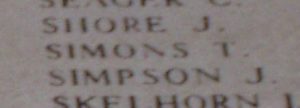
Albert Smith, Private, 76582, Royal Welsh Fusiliers. Albert was born at Ystalyfera in 1895, the son of Frederick Smith and Mary Ann Smith (nee Williams). He moved to Cefn Coed after gaining work as a collier at Castle pit, Cyfarthfa colliery as a young man. Albert married Margaret Ann Thomas in 1916 and the couple settled at 157, High Street, Cefn Coed, where their only child was born. Albert enlisted at Merthyr into the army in 1917 and was posted to Pembroke Dock to join the 3rd (Garrison) Battalion, Royal Welsh Fusiliers. The battalion was formed of men unfit for frontline duty, but who were able enough to carry out less strenuous garrison duties and formed part of the Milford Haven Defences. Albert took ill whilst based at Pembroke Dock and was taken to the Military Hospital there, where he died of heart disease on 19 May 1918. His widow brought his body home to Cefn Coed, and he was buried with full military honours in Ffrwd Cemetery. Albert is not commemorated on the Cefn Coed and Vaynor War Memorial.
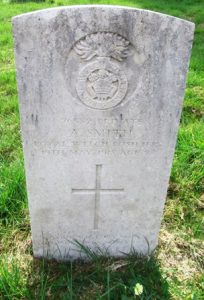
Daniel Thomas, Gunner, 741221, Royal Field Artillery. Daniel was born in 1896, the son of Lewis Thomas and Ann Thomas (nee Lewis), of 18, Field Street, Cefn Coed. He worked as a coal hewer prior to enlisting into the Royal Field Artillery at Cefn Coed. Upon being drafted to France, Daniel was posted to B Battery, 78th Brigade, Royal Field Artillery, which was attached to the 17th (Northern) Division. The division had been in France since July 1915 and had seen its first major action at the Bluff during February 1916 before moving south and fought throughout the Somme Offensive. The division then saw action during the Battle of Arras, at the First and Second Battles of the Scarpe and the Capture of Roeux, before moving back to Ypres, and took part in the First and Second Battles of Passchendaele. In March 1918 the Division was on the Somme, and faced the German Spring Offensive there, fighting at the Battle of St Quentin, and retreated back, fighting at the First Battle of Bapaume. After a period out of the line to rest and rebuild, the Division moved to the southernmost sector of the Somme area, where they fought at the Battle of Amiens on 8 August 1918, a day which saw the war swing in the favour of the Allies. The Allies then advanced on the Somme, and the Division fought at the Battle of Albert later that month, then on to the Battle of Bapaume on 31 August, and towards the Hindenburg Line, fighting at the Battle of Havrincourt on 12 September and the Battle of Épehy on 18 September. At the beginning of October, the mighty Hindenburg Line was broken, and the 17th Division swept towards Cambrai, fighting at the Battle of Cambrai on 8 October, and then north-east through northern France, towards the old Battlefields of Mons & Le Cateau, during the Pursuit to the Selle and the Battle of the Selle during the middle of October. On 25 October 78 Brigade set up its guns at Poix-du-Nord, whilst the division prepared to launch its final assault of the war, the Battle of the Sambre. Daniel was killed near here by German counter-battery fire on 31 October 1918. The 22-year-old is buried in Ovillers New Communal Cemetery, Solesmes, France.
William John Thomas, Gunner, 228326, Royal Field Artillery. William was born at Cefn Coed in 1895. He was adopted by Mary Trigg (nee Morgan) as a young boy and lived with her and her family at 99, High Street, Cefn Coed. William worked as a labourer prior to enlisting into the Royal Field Artillery on 8 December 1915 and served on the Western Front for almost two years. William’s health began to suffer towards the end of the war, and he was invalided back to Britain, joining the 1st Reserve Brigade, Royal Field Artillery. He was discharged as medically unfit on 28 November 1919 and returned home to Cefn Coed where he died of chronic arthritis on 13 January 1921. The 27-year-old is buried in Tabor Congregational Chapelyard, Cefn Coed, but is commemorated on a Special Memorial in Cardiff Western Cemetery.
Roger Vaughan, Sergeant, 2646, South Wales Borderers. Roger was born at Vaynor in 1869, the son of Watkin Vaughan and Elizabeth Vaughan (nee Williams). He married Margaret Thomas on 30 June 1901 and the couple settled at 1, Vaughan’s Terrace, Cefn Coed, where their three daughters were born over the coming years. Roger worked as a merchant and was a long serving member of the local volunteers, which became the Brecknockshire Battalion, South Wales Borderers in 1908. When war erupted, he was mobilised at Brecon, joining the 2/1st Brecknockshire Battalion, South Wales Borderers. The battalion had formed at Brecon in September 1914 as a feeder for the front-line 1/1st Brecknocks. The battalion left Brecon for Dale, in Pembrokeshire in April 1915 to join the Milford Haven garrison, then at the end of 1915 moved to Bedford to join the 68th (2nd Welsh) Division. Roger’s health was already fragile prior to this move, and he returned home to undergo an operation at the General Hospital at St. Helen’s, Swansea for peritonitis. He died there on 12 November 1914. The body of the 46-year-old was taken by train to Merthyr Station and then to his home at Cefn Coed, before he was buried with full military honours at Ffrwd Cemetery.
Harold Walton, Lance Corporal, 28368, South Wales Borderers. Harold was born on 27 February 1890, the son of George Henry Walton and Mary Ellen Walton (nee Lister), of 14, Bank Street, Brighouse, Yorkshire. He came to south Wales after gaining work as an assistant pawnbroker with Simon Harris, at Castle Street, Merthyr. Harold married Sarah Lucretia Matthews on 20 September 1914 and the couple set up home at Abercar Cottage, Cefn Coed. Harold enlisted into the South Wales Borderers at some time in 1916. Upon being drafted to France, he was posted to the 1st Battalion, South Wales Borderers, which was attached to 3 Brigade, 1st Division. The Division had followed the German retreat to the Hindenburg Line in early 1917 and was then briefed for an operation on the Flanders Coast, being relieved at the end of May 1917 and by the middle of June had taken over their new positions on the coast. While the Division was holding the line near Coxyde, the Passchendaele offensive was launched on 31 July 1917, but had got bogged down, so at the beginning of November the Division was transferred to Ypres, to join the great push for Passchendaele Ridge. After spending another Winter in Flanders, the division was near Éstaires when the German Spring Offensive caught it on 9 April 1918 and saw heavy fighting over the coming weeks before being moved South to the Arras sector. Following the launching of the great Allied offensive on 21 August 1918, the 1st Division took part in the great push towards the Hindenburg Line, pushing on towards the St. Quentin Canal, and after crossing the Hindenburg Line fought at the Battles of Beaurevoir, the Selle and the Sambre. Harold was killed when two Companies of the 1st SWB attacked a German machine-gun post on the evening of 20 October 1918. The 28-year-old is buried in Highland Cemetery, Le Cateau, France. Harold is not commemorated on the Cefn Coed and Vaynor War Memorial. His widow Sarah died in 1919.
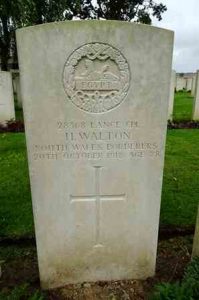
David Williams, Private, 13131, South Wales Borderers. David was born in 1876, the son of David Williams and Hannah Williams (nee Evans), of 9, Lower Vaynor Road, Cefn Coed. He worked as a coal hewer prior to enlisting at Cefn Coed into the South Wales Borderers. He embarked for France with the 1st Battalion, South Wales Borderers and disembarked at Le Havre on 13 August 1914. The battalion was attached to 3 Brigade, 1st Division and entrained for the Belgian frontier, near the town of Mons. The Division then took part in the Battle of Mons on 23 August, following the German invasion of the low countries, and in the epic withdrawal from Mons to the River Marne, where the German drive on Paris was halted. The Germans then withdrew north and took up defensive positions north of the river Aisne, along the Chemin des Dames Ridge and the BEF advanced before launching a frontal attack upon the German positions. The lines then settled down in these positions, beginning the formation of what was to become known as the Western Front. The BEF then began moving to Flanders on 17 October, before advancing from Poperinghe past endless numbers of refugees and took up positions guarding the strategically vital city of Ypres, the 1st Division taking up positions near Langemarck by 21 October. Later that day the division was attacked by hordes of Germans, mainly young student-soldiers, who were mown down by the highly trained British soldiers. The Germans maintained their attacks over the coming days but were held at bay, sustaining terrible losses, and the line here stabilised, so by 27 October the 1st Division moved to positions near Zandvoorde, guarding the Menin Road. On 31 October 1914 the 1st Division faced its sternest test so far, when the Germans attacked its positions on the Menin Road, behind a fearsome artillery bombardment and the 1st Division was almost annihilated, before being withdrawn several days later and moved to new positions near Outtersteene to rebuild. On 20 December the now rebuilt 1st SWB left for Merris, before the 1st Division took up new positions in the line at Festubert, a wet marshy area. David is officially recorded as having been killed in action at Festubert on 21 December 1914, however the 1st SWB did not enter the line there until the following day, making an assault later that afternoon, so David was most likely killed on that following day, 22 December 1914. The 38-year-old is buried in Guards Cemetery, Windy Corner, Cuinchy, France.
Evan Nicholas Williams, Gunner, 112616, Royal Field Artillery. Evan was born in 1895, the son of David Williams and Martha Williams (nee Jones), of 22, South Terrace, Cefn Coed. He worked as a collier prior to enlisting at Merthyr into the Royal Field Artillery and after completing his training was posted to B Battery, 169th Brigade, Royal Field Artillery, which was attached to the 31st Division. During December 1915 the Division moved to Egypt and took part in the defence of Suez Canal. In March 1916 it moved to France, where they saw its first major action at the Battle of Albert in July 1916. The Division took part in the assault on Serre and suffered very high casualties. It was withdrawn for several months as a result before moving back into the line in November 1916 and took part in the Battle of the Ancre, before wintering on the Ancre. The 169th Brigade set its guns up at Sailly, in miserable conditions. Evan was killed in action by German counter-battery artillery fire here on 4 January 1917. The 22-year-old is buried in Sailly-Au-Bois Military Cemetery, France.
John Llewelyn Williams, Sergeant, Gloucestershire Regiment. John was born in 1887, the son of David Williams and Annie Williams (nee Llewelyn), of 169, High Street, Cefn Coed. His parents died when he was young, so John and his brother David were raised by their aunt, Margaret Janet Evans, at 2, Morlais View Houses, Cefn Coed. John worked as a law clerk prior to the outbreak of war. He was reported to have enlisted into the Gloucestershire Regiment soon after the outbreak of war and served on the Western Front for three years with the 1/6th Battalion, Gloucestershire Regiment. John had been wounded at least once and hospitalised with fever, before being reported as missing in action in October 1917. He was later declared as having been killed in action. Sadly, at the moment, he cannot be further identified, so may have served under an alias, or been taken prisoner of war and wrongly thought of as being dead. Further research is ongoing!
Joseph Williams, Private, 9763, South Wales Borderers. Joseph was born in 1886, the son of William Williams and Anne Williams, of 29, Pontycapel Road, Cefn Coed. He left home as a young man to enlist into the South Wales Borderers and by 1911 was serving in South Africa with the 2nd Battalion, South Wales Borderers. The battalion was in Tientsin, China at the outbreak of war and took part in a famous operation with the Japanese against the German held port of Tsingtao, which began on 23 September, supporting the main Japanese landing force. Preparations for the attack proved to be slow, but the battalion luckily suffered few casualties in their advanced position, spending some of their time watching on as the Germans were bombarded by battleships anchored offshore. The first men of the 2nd SWB killed in action occurred on the night of 5-6 November while digging an advanced ‘Third Attack Position’ after the men made contact with a German sniper’s post, which they attacked and captured. The firefight prompted a German party on the left flank to pour fire into the 2nd SWB and the ensuing action killing Joseph and five other men. Joseph was 28 years old when he was killed that night. He was buried in Tsingtao British Cemetery but is commemorated on the Sai Wan (China) Memorial, Hong Kong.
Thomas Williams, Private, 1887, South Wales Borderers. Thomas was born in 1889, the son of Ann Williams, of Cefn Coed. He had married Mary Ann Lewis in about 1910 and the couple set up home at 24, Castle Square, Brecon Road, Merthyr Tydfil. Thomas worked as a collier prior to the war. He enlisted at Cefn Coed into the Brecknockshire Battalion South Wales Borderers on 20 May 1914, so was already serving with the battalion when war broke out. Thomas was mobilised with the battalion on 5 August, but the following month was posted to the newly formed 2/1st Brecknockshire Battalion, South Wales Borderer upon its formation at the Depot. The battalion left Brecon for Dale, in Pembrokeshire in April 1915 to join the Milford Haven garrison, then at the end of 1915 moved to Bedford to join the 68th (2nd Welsh) Division. In November 1916 the battalion was absorbed by the 2/7th Battalion, Royal Welsh Fusiliers at Wrentham, near South Wold, and moved to Benacre Camp, Wrentham. Thomas was hospitalised soon after his arrival in Norfolk, after having a nervous breakdown, due to being present when a German Zeppelin bombed the East Coast. His nervous state, shellshock, or nowadays PTSD, began to encroach on his day-to-day life, so Thomas was discharged from the army as medically unfit on 23 January 1917. He returned home to his wife but must have continued to suffer from his condition and was taken to the Bridgend Asylum, where he died on 17 January 1919. The body of the 31-year-old was brought back home, and he was buried in Ffrwd Cemetery. Thomas is not commemorated on the Cefn Coed and Vaynor War Memorial.
William Lewis Williams, Private, 37885, East Yorkshire Regiment. William was born in 1897, the son of Thomas Williams and Mary Charlotte Williams (nee Jones), of Gwalia House, 166A High Street, Cefn Coed. He worked as a haulier prior to enlisting into the Training Reserve at Cardiff on 26 October 1916 and was initially posted to No. 2 Depot, Royal Field Artillery for training. William embarked for France on 1 February 1917 and was transferred to the infantry, being posted to the 7th Battalion, East Yorkshire Regiment. The battalion was on the Somme, attached to 50 Brigade, 17th (Northern) Division and was holding the line near Lesboeufs when William arrived. The division followed the German withdrawal to the Hindenburg Line the following month, then in April 1917 took part in the Battle of Arras, seeing heavy fighting at the First and Second Battles of the Scarpe and took part in the Capture of Roeux. At the beginning of October, the division was relieved and moved to the Ypres Salient, to join the great fight for Passchendaele Ridge. After months of hard fighting, during the second week of December the division was relieved and moved back to the Somme sector, taking over positions south of Havrincourt, facing the Hindenburg Line. At dawn on 21 March 1918 the Germans launched the first phase of their great Spring offensive, attacking along the section of Western Front running south from Croisilles to La Fère, and the 17th Division was caught up in the ferocious fighting which ensued. The 17th Division withdraw in the direction of Velu Wood, under heavy pressure, then over the coming days withdrew past Rocquigny to Beaulencourt and Le Sars, before making a stand on Bouzincourt Ridge. On the morning of 31 March 1918, the 7th East Yorks launched a counterattack against the Germans here, but were beaten back, suffering heavy casualties. William was posted as wounded and missing during the attack but was later confirmed as having been killed in action. The 20-year-old has no known grave and is commemorated on the Arras Memorial, France.

Alfred John Willis, Private, 266549, Welsh Regiment. Alfred was born in Cardiff in 1888, the son of Colour Sergeant Henry Willis, of the Welsh Regiment, and Alice Willis (nee Tasker). By 1911 the family had moved to 4, Dan-y-Deri Lane, Cefn Coed. Alfred married Winifred Nellie Moore of Penydarren on 22 February 1914. He worked as a haulier prior to enlisting at Merthyr into the 6th Battalion, Welsh Regiment. Upon completing his training, he was drafted to Egypt to join the 1/4th Battalion, Welsh Regiment, which was attached to 158 Brigade, 53rd (Welsh) Division. The Division had been eventually evacuated from Gallipoli in December 1915, moving to Egypt to join the EEF, and helped guard the Suez Canal before taking part in operations to drive the Turks out of the Sinai. The EEF then turned its attention onto driving the Turks out of Palestine, and on 26 March 1917 launched its first offensive against the coastal city of Gaza, which guarded the road to Jerusalem. Initial gains during the day were lost when the assaulting divisions lost touch with each other, and communication broke down when a thick fog cloaked the battlefield. A second attempt to force Gaza was launched on 17 April, which also failed, and the EEF suffered a change in leadership, with Sir Edmund Allenby assuming command, before being re-organised, and a third offensive was launched against a wider front from Beersheba to Gaza on 31 October 1917. This time the Turkish defences were breached, and the road to Jerusalem now lay open and the EEF began to advance north. Alfred was killed in action during the advance to the Khuweilfeh Heights on 3 November 1917. The 29-year-old is buried in Beersheba War Cemetery, Israel. Alfred is not commemorated on the Cefn Coed and Vaynor War Memorial.
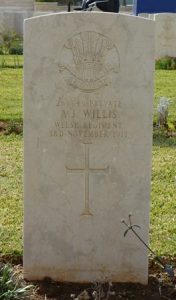
World War Two, 1939-1945
Handel Beynon, Private, 3964386, Durham Light Infantry. Handel was born in 1919, the son of David William Beynon and Martha Jane Beynon (nee Jones), of 206, High Street, Cefn Coed. He enlisted into the army and was posted to the 9th Battalion, Durham Light Infantry. The battalion was attached to the 151st Brigade, 50th (Northumbrian) Infantry Division and had been in France with the BEF in 1940, before being evacuated from Dunkirk in May. The division then spent the coming months preparing for a possible German invasion, before being despatched to North Africa and sailed from Glasgow on 23 May 1941, escorted by HMS Exeter. Upon its arrival, 150 Brigade set up around the perimeter of Alamein, whilst the rest of the division went to Cyprus, then the entire division was reunited before heading for a brief period to Iraq. In February 1942 the 69th and 151st Brigades were recalled to Egypt to join the fight against Rommel’s Afrika Korps. The division then took part in the Battle of Gazala, the action which saw Tobruk fall to the Germans, and was forced to break out through the German lines to prevent capture. The division then helped set up a new defensive line south of Mersa Matruh before taking part in the Second Battle of El Alamein later that year. The Germans were now in the process of being beaten, and Handel was killed during one of the final actions of the campaign, during the Battle of the Mareth Line, on 22 March 1943. The 24-year-old has no known grave and is commemorated on the Medjez-El-Bab Memorial, Tunisia.
Iorwerth Davies, Serjeant, 840219, Royal Artillery. Iorwerth was born in 1917, the son of George Davies and Gwenllian Davies (nee Morgans), of Cefn Coed. The family later resided at 10, Lydid Terrace, Quar, Merthyr Tydfil. Iorwerth enlisted into the Royal Artillery and was posted to the HQ of the 131st Light Anti-Aircraft Regiment, Royal Artillery. The regiment had formed in December 1941 and spent mush of the war on coastal defence along the South coast of England. The regiment proved to be very successful and was kept extremely busy during the coming months, before German raids began tailing off, however after the D-Day landings on 6 June 1944, the Germans began launching large numbers of V1 rockets against England, so the regiment moved to Dover the counter this. Iorwerth died near Hastings on 28 July 1944. The remains of the 27-year-old were brought home and he was buried in Carmel Baptist Chapelyard, Cefn Coed. Iorwerth is not commemorated on the Cefn Coed and Vaynor War Memorial.
Richard Evans, Gunner, 14285671, Royal Artillery. Richard was born in 1923, the son of Samuel Evans and Mary Evans (nee Williams), of Cefn Coed. He enlisted into the Royal Artillery and was posted to the 550th Coast Regiment, Royal Artillery. The regiment formed in June 1941 as part of the coastal defence ring around the vital port of Folkestone. Richard died in Folkestone on 31 March 1943. The remains of the 19-year-old were conveyed home and he was buried in Ffrwd Cemetery.
David William George, Gunner, 1808566, Royal Artillery. David was born on 28 May 1905, the son of John George and Mary George (nee Morgans), of Cefn Coed. He lived with his widowed mother at 3, Lower Vaynor Road, Vaynor prior to the war and worked as a labourer in a steel rolling mill. David enlisted into the Royal Artillery soon after the outbreak of war and embarked for the far east to join the 7th Coast Regiment, Royal Artillery. The regiment comprised of 4 Battery’s and manned guns at the Beting Kusha Battery and the Johore Battery, which formed part of the defensive ring around Singapore. Singapore was the foremost British military base and economic port in South–East Asia and was known as the ‘Gibraltar of the East’. It was strongly garrisoned and was thought to be impregnable. On 8 December 1941 the Japanese launched a series of simultaneous attacks against Pearl Harbour, Malaya, Thailand and the Pacific Islands. The Japanese had a force of some 30,000 troops involved in the Malayan invasion but soon reached the outer defences of Singapore following a short period of intense fighting. General Percival, commanding a garrison of some 85,000 troops in Singapore was ordered by Winston Churchill to fight to the last man, however, on 15 February 1942 he surrendered, and 80,000 troops were marched into captivity. David was taken prisoner by the Japanese following the surrender and was incarcerated at Changi Jail. In 1943 he was shipped together with hundreds of other prisoners to Thailand, to work on the infamous Thai-Burma Railway. David took ill soon afterwards, in the squalid conditions, and died of cholera at Tonchon South Camp, Thailand on 17 June 1943. The 38-year-old was originally buried in the cholera section of the camp cemetery, but after the war the graves in the cemetery were exhumed and re-interred in Kanchanaburi War Cemetery, Thailand.
William Donald Griffiths, Able Seaman, P/JX323381, Royal Navy. William was born on 21 June 1922, the son of John Griffiths and Janet Griffiths (nee Macdonald), of 5, Bryntaff, Cefn Coed. He worked as a draper’s assistant prior to enlisting into the Royal Navy and had spent the last years of the war stationed aboard the Minesweeper HMS Sefton. William remained in the Royal Navy after the war, but after nearly a year of peacetime service took ill and was invalided to Bristol Infirmary, where he died of sarcoma of the left scapula and humerus on 29 May 1946. The remains of the 22-year-old were brought home and he was buried in Ffrwd Cemetery.
William Francis Gunningham, Private, 3968180, Welch Regiment. William was born on 1 September 1915, the son of Albert James Gunningham and May Matilda Gunningham (nee Wake), of Treforest. He married Beryl Joseph, of Cefn Coed, in 1942. William had enlisted into the army and was posted to the 1/5th Battalion, Welch Regiment, the local Territorial Army unit, which was attached to 158 Brigade, 53rd (Welsh) Division. The battalion was mobilised at the outbreak of war, when the Division moved to Northern Ireland to begin garrison duties. The Division then moved to Pembroke Dock, before moving again to the south of England, where it trained in readiness for the D-Day Landings. On 24 June 1944 the 7th RWF left England for Normandy, and landed at La Riviere near Ver Sur Mer. The Division then took part in heavy fighting over the coming weeks, as part of the effort to break-out of the Normandy beachhead, seeing heavy fighting at Évrecy. On 21 July 1944 the 5th Welch were holding outposts near Le Bon Repos Crossroads, when the Germans launched a counterattack against their positions, supported by tanks. William was killed in action during the desperate defensive action which ensued that day. The 28-year-old was buried on the battlefield near Esquay, together with several other men killed in the action, but in November 1945 their graves were exhumed and re-interred in Banneville-La-Campagne War Cemetery, France.
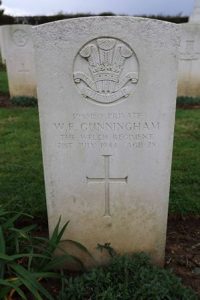
Arthur Gwynfryn Jones, Private, 5385240, Oxford and Bucks Light Infantry. Arthur was born in 1918, the son of Evan Hopkin Jones and Kate Jones (nee Roderick), of Maesycoed, Pontycapel Road, Cefn Coed. He enlisted into the army and was posted to the 4th Battalion, Oxford and Bucks Light Infantry. The battalion was attached to the 145th Infantry Brigade, 48th (South Midland) Infantry Division and embarked for France with the BEF in January 1940, following the German invasion of Poland. The Germans then launched their invasion of the Low Countries on 10 May 1940, crossing the border into northern Belgium, where the BEF was located. This attack, however, was a diversion with the main attack being through the poorly defended Ardennes Forest. Following the surrender of the Dutch army, the BEF was forced to withdraw west towards the Dendre river, before continuing to withdraw further towards the Scheldt River by 19 May. The 4th Ox and Bucks was involved in action along the line of the river Scheldt, south of Tournai, before being forced to withdraw together with the rest of the BEF, moving towards the area around Dunkirk. The evacuation of the BEF back to Britain, known as Operation Dynamo, began on 26 May. The 4th Ox and Bucks helped in the defence of Cassel until 29 May, when it became encircled near Watou and forced to surrender. The battalion had by now split into two groups with the aim of reaching Dunkirk by breaking out of its encirclement through German lines. Arthur was killed during this attempt to break out, on 1 June 1940. The 21-year-old is buried in Étaples Military Cemetery, France.
William Jones, Sergeant (Pilot), 563455, Royal Air Force. William was born in 1912, the son of Mr. and Mrs. Evan Jones, of Monumental Terrace, Cefn Coed. He had enlisted into the Royal Air Force prior to the war and on 2 December 1939 married Eileen Cardwell at Barnet, Hertfordshire. Eileen set up the family home at 28, Ravenscroft Park, Barnet. William had trained as a pilot before being posted to 206 Squadron, Royal Air Force, which was a Coastal Command unit, based at RAF Bircham Newton, in Norfolk. On 19 May 1940 William left Bircham Newton aboard a Lockheed Hudson I, Serial N7363, on a photo-reconnaissance sortie on enemy ship positions in Hamburg. The aircraft was intercepted some fifty miles from the city and was shot down into the Nordsee, with the loss of all four crew. William was 27 years old when he was lost that day. He has no known grave and is commemorated on the Runnymede Memorial, Surrey.


David Thomas Lewis, Private, 14865470, Royal Army Medical Corps. David was born in 1926, the son of John Lewis and Susannah Lewis (nee Watkins), of Cefn Coed. He enlisted into the army and was posted to the Royal Army Medical Corps. David was probably based at Aldershot towards the end of the war, as he died there, at Cambridge Military Hospital, on 4 July 1915. The body of the 19-year-old was brought home and he was buried in St. Gwendoline Churchyard, Vaynor. His mother had died just a month earlier.
David William Lewis, Warrant Officer Class III, 4075419, South Wales Borderers. David was born on 13 July 1901, the son of William David Lewis and Elizabeth Lewis. He married Rhoda Williamson in 1927 and the couple settled at the Drill Hall House, Vaynor, where David was a Sergeant with the Brecknockshire Battalion, South Wales Borderers. David continued to serve throughout the war, becoming a Warrant Officer III with the 30th Battalion, South Wales Borderers, which had formed in 1941 as a training unit. He survived the war but died at home on 18 June 1947. The 45-year-old was buried in Ffrwd Cemetery. David is not commemorated on the Cefn Coed and Vaynor War Memorial.
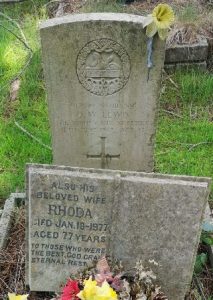
Llewellyn Morgan, Serjeant, 10592225, Royal Army Ordnance Corps. Llewellyn was born in 1913, the son of William Morgan and Sarah Anne Morgan (nee Morris), of 3, Maesteg Cottage, New Church Street, Cefn Coed. He lived at Dartford, Kent for several years prior to the war, marrying Eva Gwendoline Hattley there in 1937, before the couple came to live at 58, High Street, Cefn Coed. Llewellyn enlisted into the army and was posted to the Royal Army Ordnance Corps. He embarked for the Far East for service in India. Llewellyn died in Calcutta on 21 May 1945. The 32-year-old was buried in Calcutta (Bhowanipore) Cemetery, Kolkata, India.
Glynville William Moss, Sergeant, 1406740, Royal Air Force Volunteer Reserve. Glyn was born in 1922, the son of William Martin Moss and Annie Moss (nee Williams), of 79, High Street, Cefn Coed. He enlisted into the Royal Air Force Volunteer Reserve soon after the outbreak of war and after training as a Flight Engineer was posted to 196 Squadron, Royal Air Force, which was based at RAF Witchford, in Cambridgeshire. On 6 September 1943, Glyn took off from Witchford aboard a Short Stirling IIII, Serial EE964, which joined a large bomber force sent to hit targets in Mannheim. The Stirling crashed at Bachenau, NNW of Heilbronn, Germany that night, with the loss of seven of her eight-man crew. Glynville was 21 years old when he died as a result of the crash. He was originally buried with his fellow crewmen in Bachau Village Cemetery, but in October 1947 their graves were exhumed, and the seven men were buried together in Durnbach War Cemetery, Germany.

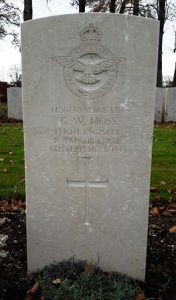
William Morgan Parry, Aircraftman 1st Class, 985584, Royal Air Force Volunteer Reserve. William was born in 1912, the son of David Parry and Catherine Mary Parry (nee Connors), of Cefn Coed. He enlisted into the Royal Air Force soon after the outbreak of war and was posted to 935 Balloon Squadron, which was based at RAF Filton, guarding the Bristol Airplane Company works at RAF Filton from German aircraft attack. William died, possibly aboard a balloon vessel in the Bristol Channel, on 10 November 1940. His death was registered at Weston-Super-Mare, so it’s likely that his body was recovered from the sea in the locality. The 28-year-old was brought home for burial in Ffrwd Cemetery.
Trevor Glyn Price, Private, S/97605, Royal Army Service Corps. Trevor was the son of William Henry Lloyd Price and Margaret Ann Price (nee Williams), of Ffynon Rosser Farm, Vaynor. He enlisted into the Royal Army Service Corps prior to war and was posted to the 1st Base Supply Depot, in France soon after the outbreak of war. Following the launching of the German Blitzkrieg, Trevor’s unit was forced to withdraw to the French coast for evacuation. The thousands of troops who had made it to Dunkirk had already been evacuated by 6 June, whilst more had been evacuated from Boulogne, Calais, and Le Havre by 25 May. More Allied troops had managed to reach ports in other parts of France, stretching from Cherbourg down to Bayonne, so the British organised Operation Aerial, to evacuate Allied forces and civilians from western France. Alfred had managed to reach St. Nazaire with most of his unit. On 17 June 1940, the requisitioned RMS Lancastria steamed into the Loire Estuary and anchored in the Charpentier Sounds. By the afternoon Lancastria had taken aboard a huge number of evacuees, far greater than she was built to carry, with estimates running from 4,000 to 9,000 people. The Germans had already begun attacking shipping in the area, and at 15.50 Lancastria was attacked by Junkers-88 bombers and sank in less than 20 minutes, with an estimated 6,500 lives being lost. Trevor was 21 years old when he died because of the sinking of the Lancastria that day. His body was later recovered from the sea, and he was buried in Noirmoutier-En-L’ile (L’herbaudiere) Communal Cemetery, France. Trevor is not commemorated on the Cefn Coed and Vaynor War Memorial, but at nearby Pontiscill.
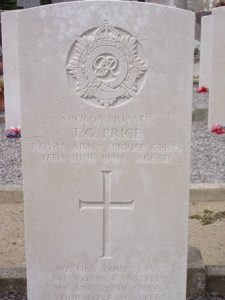
Alfred Skinner, Lance Corporal, 5773458, Royal Norfolk Regiment. Alfred was born in London in 1920, the son of William Skinner and Gladys May Skinner (nee Hughes). He married Mavis Ann Thomas, a waitress from Cefn Coed, at Vaynor in 1941. Alfred had enlisted into the army soon after the outbreak of war and was posted to the 2nd Battalion, Norfolk Regiment. The battalion had to be rebuilt following the retreat to Dunkirk in May 1940, after suffering heavy losses. Some 97 men of the battalion were murdered at the Duriez farmhouse by a unit of the 2nd Infantry Regiment of the SS Totenkopf Division. Following it’s rebuild, the battalion embarked for the Far East as part of the 4th Infantry Brigade, 2nd Infantry Division, to take part in the Burma campaign. The division became caught up in the horrific Battle of Kohima when the Japanese attempted to storm the Kohima Ridge and were caught up in ferocious fighting over the coming weeks in a gallant stand likened to the Battle of Stalingrad. Alfred was killed in action here following a counterattack by the 2nd Division on 7 May 1944. The 24-year-old was originally buried in Manipur Road British Military Cemetery, Assam, but in September 1945 his grave was exhumed, and he was re-interred in Kohima War Cemetery, India.
Joseph Cromwell Smith, Leading Aircraftman, 1152497, Royal Air Force Volunteer Reserve. Joseph was born in 1914, the son of Joseph Smith and Margaret Ann Smith (nee Evans), of Cefn Coed. He married Betty Jones at Vaynor in 1937. He enlisted into the Royal Air Force Volunteer reserve soon after the outbreak of war and after being selected for training as an Air Gunner, was posted to 9 Air Gunners School at RAF Llandwrog, in Caernarvonshire, to complete his training. On 10 October 1941 Joseph took off from Llandwrog aboard an Armstrong Whitworth Whitley Mk I, Serial K7252 on a routine training flight over Caernarvon Bay. The aircraft was heading back to the airfield and beginning its approach when it collided with another Whitley and both aircraft crashed, killing 17 men. Joseph was 27 years old when he was killed in the tragic accident that day. His body was recovered from the wreckage and brought home for burial in Cefn Coed Cemetery.
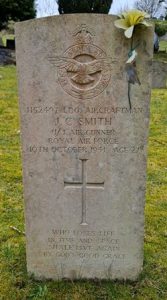
William Rees Thomas, Trooper, 3966073, Reconnaissance Corps. William was born in 1917, the son of John Thomas and Elizabeth Thomas, of Cefn Coed. He enlisted into the army and was posted to the 56th Regiment, Reconnaissance Corps. The regiment had formed in January 1941 from the 167th, 168th and 169th Brigade Anti-Tank Companies of the 56th (London) Division, but later transferred to the 78th (Battleaxe) Division following its formation in Scotland in May 1942. On 16 October, the division embarked for North Africa to take part in Operation Torch, the American landings on the Atlantic coast of Morocco and near Algiers and Oran along Algeria’s coastline. The 78th Division landed near Algiers alongside British Commandos and the U.S. 39th and 168th Regimental Combat Team and helped force the surrender of the French Army in Morocco and Algeria on 10 November. Four days later the 78th Infantry Division began to move east, along with other American and British forces, towards Bizerta and Tunis. William was killed towards the end of the Tunisian Campaign, on 27 April 1943. The 25-year-old was originally buried on the battlefield, but after the end of the war in North Africa his grave was exhumed and William was re-interred in Massicault War Cemetery, Tunisia.
Thomas Glenville Williams, Flight Sergeant, 545642, Royal Air Force. Thomas was born in 1918, the son of John Thomas Henry Williams and Myfanwy Williams (nee Joseph), of 6, Bryntaf, Vaynor. He enlisted into the Royal Air Force soon after the outbreak of war and after training as an Air Gunner was posted to 149 Squadron, Royal Air Force, which was based at RAF Lakenheath, in Suffolk. On the night of 8 December 1942 Thomas took off from Lakenheath aboard a Short Stirling I, Serial W7639 on a mining sortie in the Jasmine area off Warnemunde. The aircraft suffered technical difficulties on the outbound route and was forced to return to Lakenheath but crashed at Brandon, Suffolk with the loss of all seven of her crew. Thomas was 24 years old when he was killed during the crash. His body was recovered from the wreckage and brought home for burial in Ffrwd Cemetery.
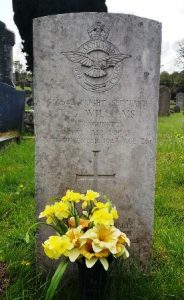
Thomas Rhys Williams, Aircraftman 2nd Class, 1259244, Royal Air Force Volunteer Reserve. Thomas was born in 1917, the son of Alun Williams and Jane Williams (nee Turner), of Eryl Taf, Cefn Coed. He enlisted into the Royal Air Force Volunteer Reserve soon after the outbreak of war and was posted to No 1 Signals School at RAF Cranwell, in Lincolnshire for training. On 23 November 1940 Thomas was walking along the banks of the river Witham near Water Lane, Lincoln, when he fell into the river and drowned. His body was not found for several weeks. The remains of the 22-year-old were brought home and he was buried in Ffrwd Cemetery.
Victor Trevor Williams, Lance Corporal, 5051004, North Staffordshire Regiment. Victor was born on 18 November 1918, the son of Charles Henry Williams and Edith Mary Williams (nee Lewis), of 4, Old Chapel Road, Cefn Coed. He married Amelia Price, of Galon Uchaf, in 1942. Victor had enlisted into the army soon after the outbreak of war and was posted to the 2nd Battalion, North Staffordshire Regiment. The battalion was attached to the 2nd Infantry Brigade, 1st Infantry Division and had been in France with the BEF at the outbreak of war, before being evacuated from Dunkirk on 1 June 1940. The battalion then spent almost three years on home defence before the 1st Division sailed for North Africa in February 1943, to take part in the final stages of the Tunisian Campaign. The division moved to the Medjez-Bou Arada sector, before beginning patrols and began preparations for an offensive to end the war in North Africa. On the night of 20/21 April the division took part in the Battle of the Medjez Plain, where it came up against the elite Hermann Göring Division. Victor was killed near a ridge known as Gueriat el Atach on 23 April 1943. The 24-year-old was originally buried on the battlefield, but after the end of the North African campaign, his grave was exhumed and he was re-interred in Massicault War Cemetery, Tunisia.